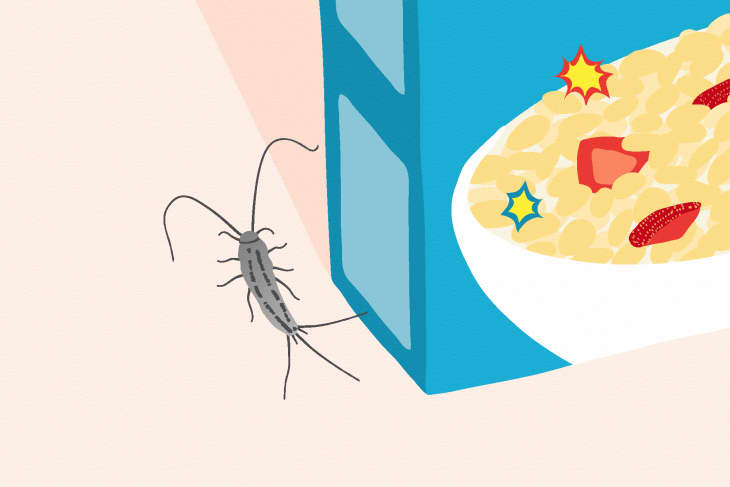Silverfish: How To Get Rid of Them and Prevent an Infestation

Bed bugs may get all the press these days, but they’re not the only creepy crawlies you might find in your home. Case in point: silverfish. While silverfish (and their cousin the firebrat — yes, real name) are pretty harmless, they sure are ugly. And it doesn’t help that they hang out in cold, dark, damp places like basements, attics, crawl spaces, and under sinks — basically, all the spots in your home you’re most likely to feature in a horror movie.
The good news is that these bugs are preventable and treatable as a DIYer, so you’re not resigned to expensive pro treatments to make your home silverfish-free. If you’ve spotted one (or more) of these lurking in your house, read on to learn more about what they are and how to get rid of them. And if you haven’t? Well, read on to learn how to keep it that way.
What are silverfish?
Silverfish are found throughout the United States in a variety of forms. (You might have also heard them called “bristletails.”) Here’s what you need to know about them.
- Silverfish get their name from their silvery-gray color.
- Silverfish might look like they have a lot of legs (like fellow common pest the house centipede) but they actually only have six, which makes them insects.
- Silverfish are about 3/4 of an inch long, with a body that’s relatively flat.
- You can recognize a silverfish by its carrot-shaped body that’s wider at the head and more narrow at the tail.
- Silverfish also have long, thread-like antennae.
- Silverfish move quickly, avoid humans, and usually come out at night, which can make them difficult to spot at first.
These bugs are icky looking, and especially creepy when they skitter out of sight, but are they harmful?
Do silverfish bite, and are they harmful?
The good news: Silverfish don’t bite or spread disease among humans. But they can be a pest in other ways. Silverfish like to eat starchy materials like paper, glue, and even pantry items. You might find evidence of their damage on the following:
- Wallpaper, especially in damp areas like bathrooms
- Books
- Dry pantry items like rolled oats and flour
- Cereal boxes
- Shoeboxes
- Clothing
Although silverfish don’t usually do moth-level damage, they can eat away at your home and your belongings over time.
Where do silverfish come from?
If a spot in your home has both moisture and starch, you’ll likely also find a silverfish. These bugs love dark and damp places, including:
- Basements
- Humid bathrooms
- Under sinks
- Attics
- Crawl spaces or other unfinished storage areas
- Kitchens and pantries
How do you get rid of silverfish in your home?
If you do find yourself with an unwelcome silverfish bug — or (gulp) an infestation — and want to do something about it, here are several natural approaches that do not require harsh chemicals:
- Sprinkling some food-grade diatomaceous earth around baseboards or other areas where you’ve spotted the silverfish. Put it in all areas where they like to hide, including cracks and small holes. Diatomaceous earth works by physically damaging bugs’ exoskeletons, making them unable to retain moisture; they die of dehydration, not poisoning.
- Try sticky traps placed in areas that you have seen or are likely to see silverfish.
- Put a starchy food like bread in a jar wrapped with masking tape. The poor suckers will climb up to get the food, then won’t be able to get out.
If you don’t have children or pets, you can try a chemical approach with silverfish poison packs.
How do you prevent silverfish?
If you see one silverfish every once in awhile, it’s not a huge deal; you can grab them with a tissue or paper towel as needed. It’s when they show up in greater numbers that you might justifiably start getting heebie-jeebies. To discourage them from arriving in droves, take the following preventative measures:
- Put out some cedar, or spray crevices with cedar oil. Silverfish reportedly don’t like the stuff, so they steer clear.
- Some people report that dried bay leaves are an effective insect repellant. Insects don’t like the smell.
- Don’t leave piles of newspapers, mail, or other ephemera lying around. Get rid of any old cardboard boxes, especially in the basement.
- Store off-season clothing in sealed bins and somewhere dry.
- Vacuum regularly to pick up food crumbs (and potentially suck up any eggs).
- Keep dry food in tightly sealed pantry containers.
- Seal any cracks or crevices with caulk to keep silverfish from entering the home, or laying eggs while they’re in there.
Long term, you also want to deal with any moisture problems. Here’s how:
- Use a dehumidifier.
- Install a more efficient bathroom fan for showers.
- Check the outside perimeter of your home and clear away any leaves and other damp debris.